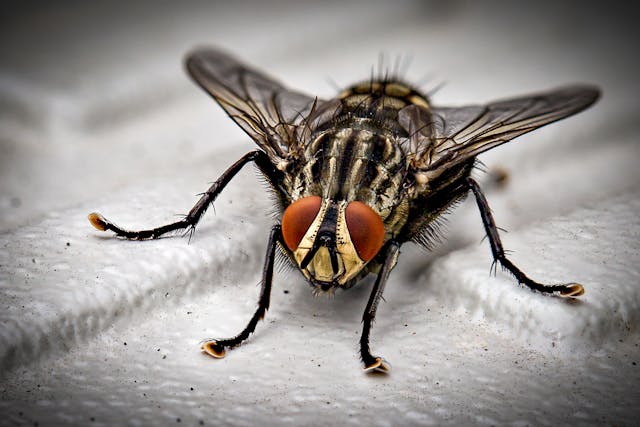
Why do flies buzz and cicadas and crickets chirp? Flies buzz because of how fast their wings have to move, cicadas chirp by flexing their tymbal, and crickets rub their wings together.
Flies aren’t the only insects that buzz. The majority of insects produce some kind of buzzing sound when they fly. Some insects produce it intentionally as a way of signaling to other flies and they can also detect the buzz from other insects. Some insects appear to be silent to us because they make a buzz that is higher than we can hear.
So, why do flies buzz? It is because their wings are so small. For anything to fly, there are four forces that are important. Those are weight, thrust, drag, and lift. Thrust needs to be strong enough so lift can overcome weight and drag. Planes get over this by having large engines and large wings. Birds can fly because they angle their wings enough to provide thrust and lift at the same time. Their wing muscles provide the power that a plane’s engine does, and the downward movement pushes the bird forwards and upwards. Generally, the heavier the bird the larger the wings they have because they need enough thrust and lift to overcome their weight. However, larger wings produce more lift than smaller wings because they have more surface area. That means a bird with larger wings doesn’t have to flap as quickly as a bird with smaller wings because each flap produces more lift. An eagle flaps approximately one to three times a second. As birds get smaller, they have to flap faster and faster. When we get down to the smallest bird, the hummingbird, it flaps about 70 times a second. This is because it doesn’t get as much lift with each tiny wing and has to flap them much faster to stay aloft. When we get down to an insect the size of a fly, their wings have a very small surface area, and they have to flap them extremely quickly to stay in the air. A fly flaps its wings about 200 times a second. The even smaller mosquito flaps its wings about 1,000 times a second.
When a bird flaps, its wings displace air, which creates a sound wave. We can’t hear it because it is lower than the lowest sound we can hear, which is 20 Hz. 20 Hz is 20 sound waves a second, and the bird is producing 3 sound waves a second. A fly moves its wings 200 times a second and creates 200 sound waves a second, which we can hear. That is the buzzing sound. A mosquito creates 1,000 sound waves a second, which we can also hear, but it is much faster than a fly, so it is a much higher pitched sound. Mosquitos can even hear the buzzing of other mosquitos and they use them to communicate.
Cicadas and crickets both make a chirping sound, but they have a different mechanism of doing it. The sound of cicadas is the sound of summer in many countries. Cicadas live under the ground until the temperature gets to about 18℃ and then they climb up into the trees, where they start to make their chirping. The sound is only made by the males, and they are doing it to attract females. They make the sound by flexing an organ called a tymbal. The tymbal is a stiff membrane that has ribs on one side and is connected to a muscle. When the cicada contracts the muscle, the tymbal flexes and the ribs buckle, clicking against each other. When the muscle is relaxed, the tymbal returns to its original shape. The cicada can flex this muscle about 480 times a second, producing the sound we can hear. Cicadas also have an air sac that can vibrate at the same frequency as it flexes the muscle, and this strongly amplifies the sound. As the air sac runs out of air, the sound goes down, which is why the cicada sound has a wavelike sound.
Crickets produce their chirping by rubbing their wings together, a process called stridulation. Again, as with the cicadas, it is only the males that make the sound, and they are trying to attract females. Both crickets and cicadas can detect sound vibrations through “ears” on their bodies. Crickets have front wings that have a file and scraper. The file wing has a series of rough bumps on one edge. The scraper wing has a hardened edge. When the cricket rubs the scraper against the file, the vibrations produce a sound wave, which is the chirping we can hear. Grasshoppers and locusts can also make this sound, but they have the file part on their legs and the scraper on their wings, so they rub their legs against their wings. And this is what I learned today.
Sources
https://biolearn.eu/en/future/cool-activities/flap-like-an-eagle
https://en.wikipedia.org/wiki/Bird_flight
https://www.nature.com/articles/21996.pdf
https://news.ncbs.res.in/research/secrets-buzzing-flies
https://naturemuseum.org/chicago-academy-of-sciences/blog/how-do-cicadas-make-sound
https://www.britannica.com/story/why-are-cicadas-so-noisy
https://www.terminix.com/blog/science-nature/why-crickets-chirp
